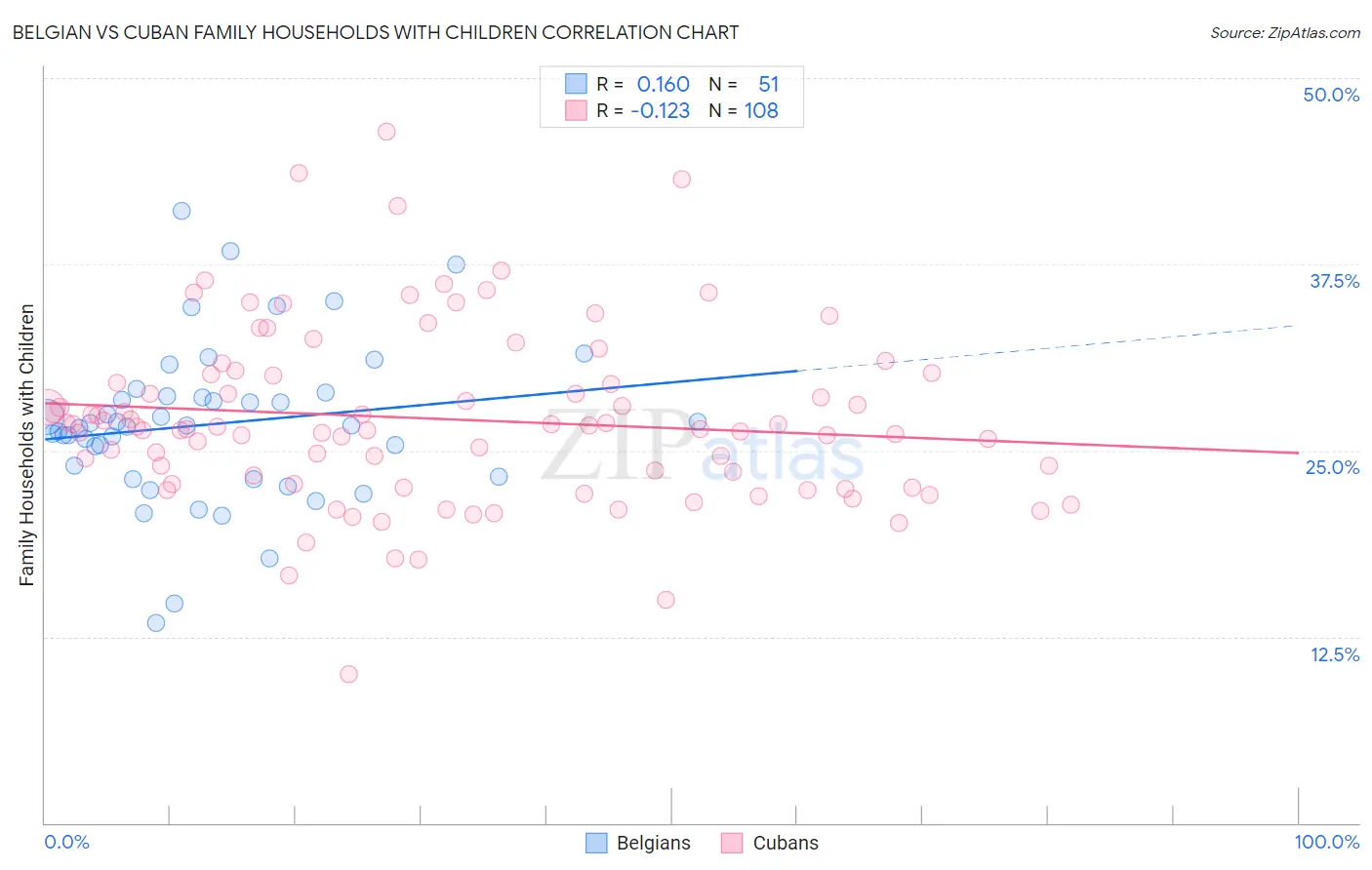Belgian vs Cuban Family Households with Children
COMPARE
Belgian
Cuban
Family Households with Children
Family Households with Children Comparison
Belgians
Cubans
26.9%
FAMILY HOUSEHOLDS WITH CHILDREN
2.1/ 100
METRIC RATING
250th/ 347
METRIC RANK
27.1%
FAMILY HOUSEHOLDS WITH CHILDREN
12.2/ 100
METRIC RATING
216th/ 347
METRIC RANK
Belgian vs Cuban Family Households with Children Correlation Chart
The statistical analysis conducted on geographies consisting of 355,692,100 people shows a poor positive correlation between the proportion of Belgians and percentage of family households with children in the United States with a correlation coefficient (R) of 0.160 and weighted average of 26.9%. Similarly, the statistical analysis conducted on geographies consisting of 448,752,721 people shows a poor negative correlation between the proportion of Cubans and percentage of family households with children in the United States with a correlation coefficient (R) of -0.123 and weighted average of 27.1%, a difference of 1.1%.

Family Households with Children Correlation Summary
| Measurement | Belgian | Cuban |
| Minimum | 13.4% | 10.0% |
| Maximum | 41.1% | 46.4% |
| Range | 27.7% | 36.4% |
| Mean | 26.8% | 27.1% |
| Median | 26.6% | 26.5% |
| Interquartile 25% (IQ1) | 23.3% | 22.8% |
| Interquartile 75% (IQ3) | 28.6% | 30.1% |
| Interquartile Range (IQR) | 5.4% | 7.3% |
| Standard Deviation (Sample) | 5.3% | 6.0% |
| Standard Deviation (Population) | 5.2% | 6.0% |
Similar Demographics by Family Households with Children
Demographics Similar to Belgians by Family Households with Children
In terms of family households with children, the demographic groups most similar to Belgians are Immigrants from Eastern Europe (26.9%, a difference of 0.010%), Immigrants from Kazakhstan (26.9%, a difference of 0.020%), Potawatomi (26.9%, a difference of 0.030%), Immigrants from Bosnia and Herzegovina (26.8%, a difference of 0.060%), and Irish (26.8%, a difference of 0.090%).
| Demographics | Rating | Rank | Family Households with Children |
| Immigrants | Saudi Arabia | 2.9 /100 | #243 | Tragic 26.9% |
| Ukrainians | 2.9 /100 | #244 | Tragic 26.9% |
| Australians | 2.8 /100 | #245 | Tragic 26.9% |
| Jamaicans | 2.5 /100 | #246 | Tragic 26.9% |
| Potawatomi | 2.2 /100 | #247 | Tragic 26.9% |
| Immigrants | Kazakhstan | 2.2 /100 | #248 | Tragic 26.9% |
| Immigrants | Eastern Europe | 2.1 /100 | #249 | Tragic 26.9% |
| Belgians | 2.1 /100 | #250 | Tragic 26.9% |
| Immigrants | Bosnia and Herzegovina | 1.9 /100 | #251 | Tragic 26.8% |
| Irish | 1.8 /100 | #252 | Tragic 26.8% |
| Italians | 1.5 /100 | #253 | Tragic 26.8% |
| Immigrants | Scotland | 1.5 /100 | #254 | Tragic 26.8% |
| German Russians | 1.5 /100 | #255 | Tragic 26.8% |
| Scotch-Irish | 1.4 /100 | #256 | Tragic 26.8% |
| Slavs | 1.3 /100 | #257 | Tragic 26.8% |
Demographics Similar to Cubans by Family Households with Children
In terms of family households with children, the demographic groups most similar to Cubans are U.S. Virgin Islander (27.1%, a difference of 0.0%), Northern European (27.2%, a difference of 0.030%), African (27.2%, a difference of 0.040%), Greek (27.1%, a difference of 0.040%), and Immigrants from Dominica (27.2%, a difference of 0.080%).
| Demographics | Rating | Rank | Family Households with Children |
| Dutch West Indians | 15.8 /100 | #209 | Poor 27.2% |
| Immigrants | Ukraine | 14.4 /100 | #210 | Poor 27.2% |
| Welsh | 14.2 /100 | #211 | Poor 27.2% |
| Immigrants | Dominica | 13.9 /100 | #212 | Poor 27.2% |
| Okinawans | 13.7 /100 | #213 | Poor 27.2% |
| Africans | 13.0 /100 | #214 | Poor 27.2% |
| Northern Europeans | 12.8 /100 | #215 | Poor 27.2% |
| Cubans | 12.2 /100 | #216 | Poor 27.1% |
| U.S. Virgin Islanders | 12.1 /100 | #217 | Poor 27.1% |
| Greeks | 11.4 /100 | #218 | Poor 27.1% |
| Immigrants | Japan | 10.7 /100 | #219 | Poor 27.1% |
| Austrians | 9.9 /100 | #220 | Tragic 27.1% |
| New Zealanders | 9.6 /100 | #221 | Tragic 27.1% |
| Paraguayans | 9.4 /100 | #222 | Tragic 27.1% |
| Pima | 9.2 /100 | #223 | Tragic 27.1% |